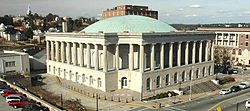
Macon, officially Macon–Bibb County, is a consolidated city-county in Georgia, United States. Situated near the fall line of the Ocmulgee River, it is 85 miles (137 km) southeast of Atlanta and near the state's geographic center—hence its nickname "The Heart of Georgia."

The Auditorium Building in Chicago is one of the best-known designs of Louis Sullivan and Dankmar Adler. Completed in 1889, the building is located at the northwest corner of South Michigan Avenue and Ida B. Wells Drive. The building was designed to be a multi-use complex, including offices, a theater, and a hotel. As a young apprentice, Frank Lloyd Wright worked on some of the interior design.
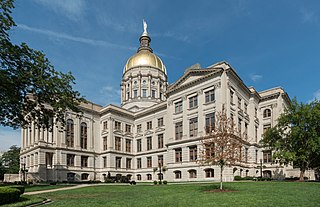
The Georgia State Capitol is an architecturally and historically significant building in Atlanta, Georgia, United States. The building has been named a National Historic Landmark which is listed on the National Register of Historic Places. As the primary office building of Georgia's government, the capitol houses the offices of the governor, lieutenant governor, and secretary of state on the second floor, chambers in which the General Assembly, consisting of the Georgia State Senate and Georgia House of Representatives, meets annually from January to April. The fourth floor houses visitors' galleries overlooking the legislative chambers and a museum located near the rotunda in which a statue of Miss Freedom caps the dome.
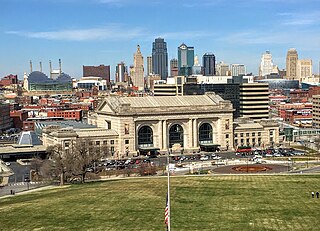
Downtown Kansas City is the central business district (CBD) of Kansas City, Missouri and the Kansas City metropolitan area which contains 3.8% of the area's employment. It is between the Missouri River in the north, to 31st Street in the south; and from the Kansas–Missouri state line eastward to Bruce R. Watkins Drive as defined by the Downtown Council of Kansas City; the 2010 Greater Downtown Area Plan formulated by the City of Kansas City defines the Greater Downtown Area to be the city limits of North Kansas City and Missouri to the north, the Kansas–Missouri state line to the west, 31st Street to the south and Woodland Avenue to the east. However, the definition used by the Downtown Council is the most commonly accepted.

The Calumet Theatre is a historic theatre located at 340 Sixth Street in the town of Calumet, Michigan. It is also known as the Calumet Opera House or the Calumet Civic Auditorium. It is integral to, but a separate unit of, the Calumet municipal building. The structure was designated a Michigan State Historic Site in 1971 and added to the National Register of Historic Places in 1971. It is one of the 21 Heritage Sites which partners with the Keweenaw National Historical Park. The theatre was the original home of The Red Jacket Jamboree, an old-time radio variety show.
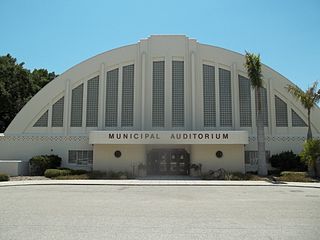
The Sarasota Municipal Auditorium, listed in the National Register as Municipal Auditorium-Recreation Club, is a historic multi-purpose facility built-in 1938. It is located at 801 Tamiami Trail North and is owned/operated by the municipal government of Sarasota, Florida. The auditorium has 10,000 square feet (930 m2) of exhibit space on its main floor and also contains an Art Deco style stage measuring 1,500 square feet (140 m2).

The Woodbury County Courthouse is located at 620 Douglas Street in Sioux City, the county seat of Woodbury County, Iowa, United States. It is regarded as "one of the finest Prairie School buildings in the United States" and has been declared a National Historic Landmark for its architecture. It is used for legal proceedings in the county.

The Cultural Center Historic District is a historic district located in Detroit, Michigan, which includes the Art Center : the Detroit Public Library, the Detroit Institute of Arts, and the Horace H. Rackham Education Memorial Building were listed on the National Register of Historic Places in 1983. The district contains several cultural attractions.

The Crawford County Courthouse is in Denison, Iowa, United States, the county seat of Crawford County. It was listed on the National Register of Historic Places in 1981. The courthouse is the second building the county has used for court functions and county administration.

The Civic Center Music Hall is a performing arts center located in Oklahoma City, Oklahoma. It was constructed in 1937 as Municipal Auditorium and renamed in 1966. The facility includes the Thelma Gaylord Performing Arts Theatre, the Freede Little Theatre, CitySpace, the Meinders Hall of Mirrors and the Joel Levine Rehearsal Hall.

The Soldiers and Sailors Memorial Coliseum is a multi-purpose auditorium and meeting space in downtown Evansville, Indiana.

The Pioneer Center for the Performing Arts is a theater located in Reno, Nevada. It was designed by the Oklahoma City architectural firm of Bozalis, Dickinson and Roloff as a concrete structure with a distinctive gold geodesic dome roof. The facility was completed in 1967 with 987 seats on the main level and 513 seats in a balcony, totaling to 1,500. The co-founder of Temcor, the project's contractor, was Don Richter, a student of Buckminster Fuller, developer of the geodesic dome concept. Temcor had built several gold-anodized aluminum domes before the Pioneer, and was responsible for more than 5000 dome projects.

Lisner Auditorium is a performance venue sited on the Foggy Bottom campus of George Washington University at 730 21st Street Northwest, Washington, D.C. Named for Abram Lisner (1852-1938), a university trustee and benefactor whose will provided one million dollars towards its construction, it was designed in 1940 and completed in 1946. Constructed in the stripped classicist style of the late Art Deco and host to major classical, folk, rock, blues, opera, and theatrical performances over the decades, it was placed on the National Register of Historic Places in 1990 for its dual significance as an architectural work and as a performance venue.
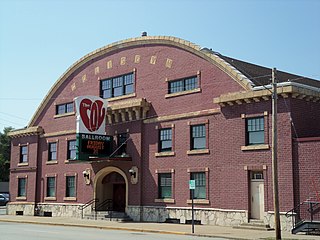
The Col Ballroom is a historic building located in the West End of Davenport, Iowa, United States. It was listed on the National Register of Historic Places and on the Davenport Register of Historic Properties as the Saengerfest Halle.

The First Congregational Church, also known as Iglesia Pentecostes Evangelica Principe de Paz, is a house of worship located in Sioux City, Iowa, United States. An architectural rarity, it is one of a small group of churches in the Prairie School style of architecture. Designed primarily in the Prairie style with some eclectic touches by architect William L. Steele, its horizontal lines are emphasized by Roman brick and crisp rectilinear forms. Somewhat at variance are the distinctive dome and the prominent round heads on the windows.

The Carson City Civic Auditorium, at 813 N. Carson St. in Carson City, Nevada, was designed by architect Lehman A. Ferris and was built during 1938–39. It was funded by a municipal bond and by the Public Works Administration. Also known simply as Municipal Auditorium, it was listed on the National Register of Historic Places in 1990. Since 1994, the building has served as the location for the Children's Museum of Northern Nevada.

Hawkinsville Opera House, originally known as the City Auditorium and sometimes referred to as Hawkinsville City Hall-Auditorium, is a theater building in downtown Hawkinsville, Georgia. It was built in 1907 after the city awarded a contract for a performing arts building to be constructed at a cost of $16,470. It was designed by Macon, Georgia architect and theater designer W.R. Gunn. With 576 seats, the theater had the largest seating capacity of any public building in Pulaski County, Georgia. It was added to the National Register of Historic Places in 1973 and underwent a 1.7 million dollar renovation 2000. It is managed by the non-profit Hawkinsville-Pulaski County Arts Council.

The Dearborn City Hall Complex is a complex of three government buildings located at 13615 Michigan Avenue in Dearborn, Michigan. The complex includes the 1921 Dearborn City Hall, the 1929 Police and Municipal Courts Building, and an office/auditorium concourse addition constructed in 1981. The complex was listed on the National Register of Historic Places in 2014.

Ellamae Ellis League, was an American architect, the fourth woman registered architect in Georgia and "one of Georgia and the South's most prominent female architects." She practiced for over 50 years, 41 of them from her own firm. From a family of architects, she was the first woman elected a Fellow of the American Institute of Architects (FAIA) in Georgia and only the eighth woman nationwide. Several buildings she designed are listed on the National Register of Historic Places (NRHP). In 2016 she was posthumously named a Georgia Woman of Achievement.
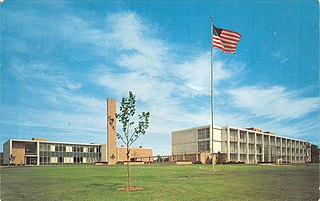
The City of Flint Municipal Center is a complex of seven government office buildings located at 1101 Saginaw Street, 210 East Fifth Street, 310 East Fifth Street in Flint, Michigan. The area was listed on the National Register of Historic Places in 2019.
